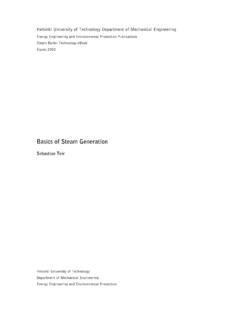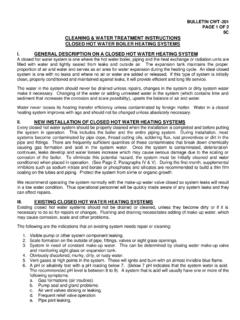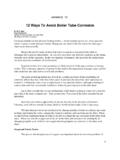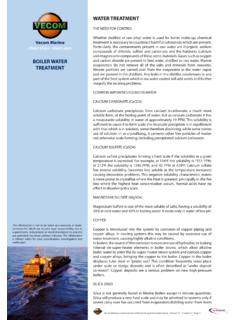Transcription of Boiler Calculations - KTH
1 Helsinki University of Technology Department of Mechanical Engineering Energy Engineering and Environmental Protection Publications Steam Boiler Technology eBook Espoo 2002 Boiler Calculations Sebastian Teir, Antto Kulla Helsinki University of Technology Department of Mechanical Engineering Energy Engineering and Environmental Protection iiTable of contents Steam/ water diagrams used in Boiler Calculations ..1 Temperature-heat (T-Q) 1 Temperature-entropy (T-s) 2 Pressure-enthalpy (p-h) diagram .. 3 Enthalpy-entropy (Mollier, h-s) diagram ..4 Determination of steam/ water parameters .. 5 Given parameters .. 5 Pressure 5 Procedure for determination of specific enthalpies and mass flow rates .. 6 Superheaters and 7 Spray water group mass 7 Calculations of heat 8 Evaporator .. 8 9 Reheater .. 9 Economizer .. 9 Air preheater .. 9 Determination of Boiler efficiency .. 10 Standards .. 10 Major heat 10 Heat loss with unburned combustible gases.
2 10 Heat loss due to unburned solid fuel .. 10 Heat loss due to wasted heat in flue gases .. 11 Heat loss due to wasted heat in ashes .. 11 Losses due to heat transfer (radiation) to the environment .. 12 Losses of blowdown, sootblowing and atomizing 12 Internal power 12 Calculating Boiler efficiency .. 12 Direct 13 Indirect method .. 13 References .. 14 1 Steam/ water diagrams used in Boiler Calculations Temperature-heat (T-Q) diagram The T-Q diagram is a useful tool for designing heat exchangers. It can also be used to present the heat transfer characteristics of an existing heat exchanger or heat exchanger network. The T-Q diagram consists of two axes: The current stream temperature on the y-axis and the amount of heat transferred on the x-axis. Sometimes the streams are marked with arrowheads to clarify the direction of the streams, but these are not necessary: since heat cannot move from the colder stream to the hotter stream according to the second law of thermodynamics, the directions of the streams are explicitly determined: The hot stream transfers its heat to the cold stream, thus the flow direction of the hot stream is towards lower temperature and the flow direction of the cold stream is towards higher temperatures.
3 For the same reason, the hot stream is always above the cold stream in the T-Q diagram (figure 1). Figure 1: Examples of T-Q diagrams for a parallel flow heat exchanger (left), and a counter (or cross) flow heat exchanger (middle). The hot stream is marked with red color and the cold with blue color. When designing or reviewing heat exchanger networks, the T-Q diagram gets useful. The T-Q diagram is therefore applied when designing boilers; especially the heat exchanger surface arrangement can be clearly visualized with a T-Q diagram (figure 2). 020040060080010001200140016000 %10 %20 %30 %40 %50 %60 %70 %80 %90 %100 %Share of heat load [%]Temperature [ C]Flue gas streamWater/steam streamAir streamFurnaceSuperheaterEconomizerAir preheater Figure 2: Example of a T-Q diagram representing the heat surfaces in a PCF Boiler .
4 2 Temperature-entropy (T-s) diagram The T-s diagram represents the various phases of steam/ water with temperature as a function of the specific entropy. It is often used to visualize steam power processes. The T-s diagram is also commonly used for displaying reversible processes (or real processes simplified as reversible processes), which in the T-s diagram appear as closed curves (loop). The left border, up to the critical point, is the border where the liquid is saturated (figure 3). That is, the water is still liquid and contains no steam. But if we go further right (increase the entropy), steam bubbles starts to form in the water . In other words, saturated water starts to boil when heat is added and entropy is increased. The enclosed region in the middle is the region where water is a mixture of vapor and liquid. Steam that contains water in any form, either as minute droplets, mist or fog, is called wet steam.
5 The quantity called x in the diagram Critical pointp = constantp = constantp = constantp = constantv = constantv = constantLiquid-vapour regionSaturated vapourSaturated liquidX = 0,2X = 0,9 TemperatureEntropy Figure 3: Simplified T-s diagram of steam/ water . represents the amount (percentage by weight) of dry vapor in the wet steam mixture. This quantity is called the quality of steam. For instance, if there is 10 % moisture in the steam, the quality of the steam is 90 % or 0,9. The temperature of wet steam is the same as dry saturated steam at the same pressure. The right border, down from the critical point, is the line where steam is saturated. When steam is heated beyond that border, steam is called superheated. water boils under constant temperature and pressure, so a horizontal line inside the enclosed region represents a vaporization process in the T-s diagram. The steam/ water heating process in the Boiler represented by the diagram in figure 2 can also be drawn in a T-s diagram (figure 4), if the Boiler pressure is assumed to be 10 MPa.
6 3 Figure 4: Detailed T-s diagram of the PCF Boiler steam/ water heating process from figure 2 (note: color of the steam/ water process line is changed from blue to red). Pressure-enthalpy (p-h) diagram Another tool used in Boiler calculation is the pressure-enthalpy diagram for steam/ water (figure 5). With the p-h diagram it is easy to visualize the partial shares of the total heat load on different heat exchanger surfaces in the Boiler : drawing the steam heating process in the Boiler onto the p-h diagram will give a horizontal line (if we simplify the process and set pressure losses to zero). Figure 6 shows the same Boiler steam/ water process from figure 4, drawn in the steam/ water p-h diagram. 60 C100 C200 C300 C400 C500 C 600 C0500100015002000250030003500400010 kPa100 kPa1 MPa10 Mpa20 MPa50 MPaEnthalpy [kJ/kg]PressureCritical pointSaturated vaporSaturated liquid Figure 5: Simplified p-h diagram for steam/ water .
7 4 Figure 6: Detailed p-h diagram of the PCF Boiler steam/ water heating process (red line) from figure 4. Enthalpy-entropy (Mollier, h-s) diagram The most frequently used tool for determining steam properties is probably the enthalpy-entropy (h-s) diagram, also called Mollier diagram (figure 7). If two properties of the steam state are known (like pressure and temperature), the rest of the properties for steam (enthalpy, entropy, specific volume and moisture content) can be read from the diagram. A more detailed h-s diagram can be found in figure 8. Since the diagram is very large, the diagram is usually found as two versions, consisting of zoomed portions of the original: one for steam properties (figure 7) and another for water properties. Critical pointp = constantp = constantT = constantT = constantLiquid-vapour regionX = 0,96X = 0,90 Saturated vapour Figure 7: Mollier (h-s) diagram, simplified version.
8 5 Figure 8: Large-scale Mollier h-s diagram for steam. Determination of steam/ water parameters Given parameters Normally in a steam Boiler design assignment the parameters describing the live (output) steam, mass flow, pressure and temperature are given. If the steam Boiler to be designed has a reheat cycle, also reheat pressure and temperature are given. Reheat steam mass flow can be given as well. These parameters are used to determine the rest of the steam/ water parameters. Pressure losses The pressure losses in the heat exchanger units of the Boiler are estimated according to the following approximations: Economizer: the pressure loss is 5-10 % of the pressure of the feedwater entering the economizer. Evaporator: Once through boilers: in once-through boilers the pressure loss of the evaporator is between 5 and 30 %. Forced and natural circulation boilers: the pressure drop in the evaporator part of drum-based boilers does not affect the pressure loss of the main steam/ water flow through the Boiler .
9 This means that saturated steam leaving the steam drum has the same pressure as the feedwater entering the steam drum. The pressure loss of the evaporator has to be overcome using the driving force (natural circulation) or circulation pump (forced circulation). 6 Superheater: the total pressure drop of all superheater packages is less than 10 % of the pressure of the superheated steam. Reheater: the pressure drop in the reheater is about 5 % of the pressure of reheated steam Pressure losses of connection tubes between different heat transfer surfaces ( between evaporator and superheater) can be neglected in these Calculations . Procedure for determination of specific enthalpies and mass flow rates 1. The specific enthalpy of the superheated steam can be determined with an h-s diagram if both the temperature and the pressure of the steam are known. Thus, the specific enthalpies for live (superheated) steam and reheated steam can be calculated.
10 2. The total pressure loss of the superheater stages should be chosen. Thus, the pressure in steam drum (drum-type boilers) or pressure after evaporator (once-through boilers) can be calculated by adding the pressure loss over the superheater stages to the pressure of the superheated steam. 3. Specific enthalpy of saturated water and steam (in the steam drum) can be read from an h-s diagram or steam tables, as the pressure in the steam drum is known. In once-through boilers the determination of specific enthalpy after the evaporator is based on the temperature. The reason for this is the unclear state of supercritical steam after the evaporator in once-through circulation. The temperature after the evaporator in once-through boilers is typically between 400 and 450 C. 4. For removal of minerals concentrated in the steam drum, a part of the water in steam drum is removed as blowdown water from the bottom of the steam drum.








